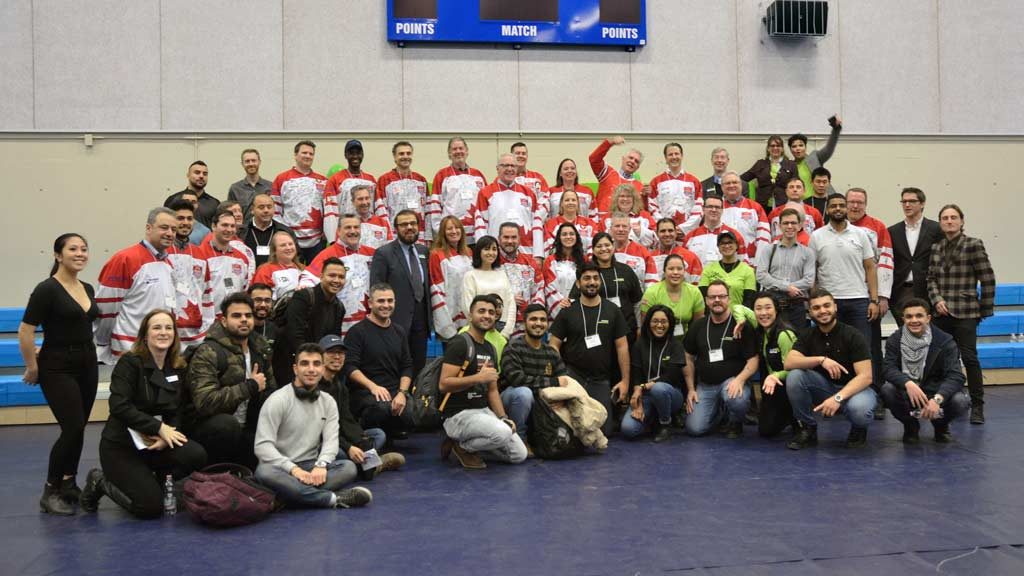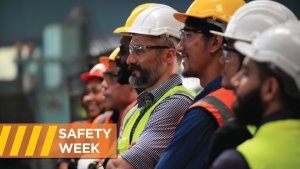George Brown College students recently got some valuable lessons from safety champions.
The George Brown College Centre for Construction and Engineering Technologies (CCET) hosted the League of Champions’ Safety at Work Event held at the Casa Loma campus Jan. 30. Over 20 safety leaders donning their “jerseys of courage” were in attendance to educate CCET students on workplace safety and the importance of working for an employer who values safe work.
The League of Champions exists to help companies build a safety culture and be recognized for their leadership. In partnership with MySafeWork, the group promotes safety in construction and all industries.
Craig Lesurf, president of Gillam Group who moderated the discussion, shared a personal story about a neighbour he had growing up, a crane operator, who was involved in a workplace fatality.
“One day something happened — he made a mistake and he killed someone,” recalled Lesurf.
“It only takes one moment, a momentary lapse in judgment for something to happen… It was just one moment in time and it ruined dozens of people’s lives. He was no longer the life of the party. He was never the same again. He turned into an introvert. He died young. It totally ruined his life, it ruined his family’s life and everyone around him.”
Clive Thurston, president of the Ontario General Contractors Association, told students he is an injured worker.
“I am a survivor,” he said pointing to his leg with a cane. “Twelve surgeries all on one leg…a lot of people here today have stories from my generation when safety was not paramount.”
He recalled a rainy day about 20 years ago when he was told by his employer to climb a ladder to check a leaky roof. He fell and tore up his leg.
“I was sent to do a job I should not have been sent to do,” said Thurston. “We didn’t get the right to refuse work in those days.
“You have that right and you should exercise it. No one should put their life at risk, nobody should put their body at risk.”
Donna Scrimgeour, senior project manager at Aecon Construction, said the company has been focusing on mental health, especially in the past year. She told an emotional story of losing a coordinator in the company to suicide.
“He didn’t speak up soon enough to get help,” she said, adding the day before was Bell Let’s Talk Day devoted to mental health. “It’s terribly important. You’ve got to speak up, you’ve got to get help. It doesn’t just affect the individual, it affects everyone around them.”
Dan Fleming, manager at NORCAT, asked the students what they think the biggest killer in the construction industry is. While most of them said falls, Fleming noted occupation disease claims more lives every year.
“People are dying from occupational diseases everyday across Canada,” said Fleming, whose father worked as a boilermaker. “My dad passed away 10 years ago at the age of 69. He was only six years into retirement. He died from lung cancer directly related to asbestos. We have guys that work in construction their whole lives and go to retire and collect a pension and only have three to five years.”
Ontario’s Chief Prevention Officer Ron Kelusky said the fatality statistics in general for 2019 showed a substantial improvement over the prior year 2018 and the greatest improvement was in the construction sector. He said programs like COR, working at heights training and the League of Champions help improve those numbers.
“While 2019 has shown a positive shift, the long-term goal is to ensure both a continued and sustained reduction of fatalities into the future,” said Kelusky. “Construction fatalities were down 36 per cent over 2018 and fatalities specifically from falls from heights in construction was down 50 per cent.”
Enzo Garritano, president of the Infrastructure Health & Safety Association ,said knowledge is power.
“When it comes to health and safety, there is an opportunity for you because you have that ability to learn as much about what is going on in that company or in that sector as you can,” said Garritano. “There are a lot of resources out there so take advantage of that. Find information around risk and prevention methods before you go to work, before you get exposed to whatever you’re going into because that’s going to empower you when you get hired to make a judgment call that this company is doing what they’re supposed to do or they’re not doing what they’re supposed to do. Be prepared.”
John Mollenhauer, president of the Toronto Construction Association, told students they not only have a right to refuse unsafe work, but they also have a right to choose which company they work for.
“If you are interviewing for an employer and they are asking you questions about your resume and that is vitally important for them to make the right choice, you have a right to make the right choice too,” said Mollenhauer.
“You have the right to talk to the employer — big or small, it doesn’t matter — about their safety protocols, about their safety culture.”











You always have the right to refuse. Also supervisor roles need to be more strict with foreman certification criteria. Employers overwhelmed with work stick a body onsite to satisfy the regs. Employers or foreman don’t want to pass on work but inexperience and compliance are always a factor.
When a major task takes place everyone notices and seems to prepare for but it is the minor daily task that seem to create the incidents and accidents.
You can still have accidents but do your best to avoid or to prepare for one as when it goes wrong, everything goes wrong